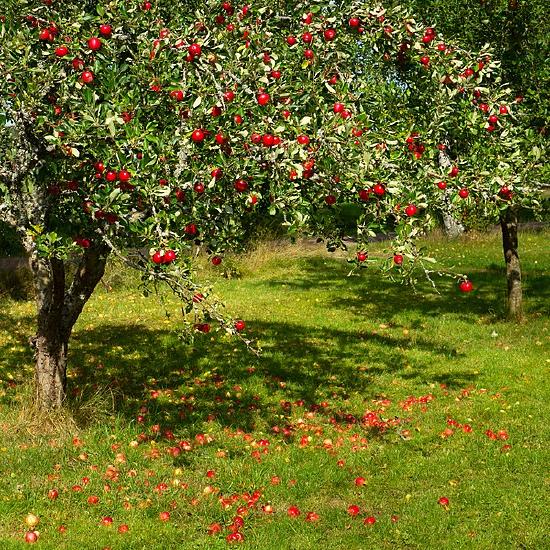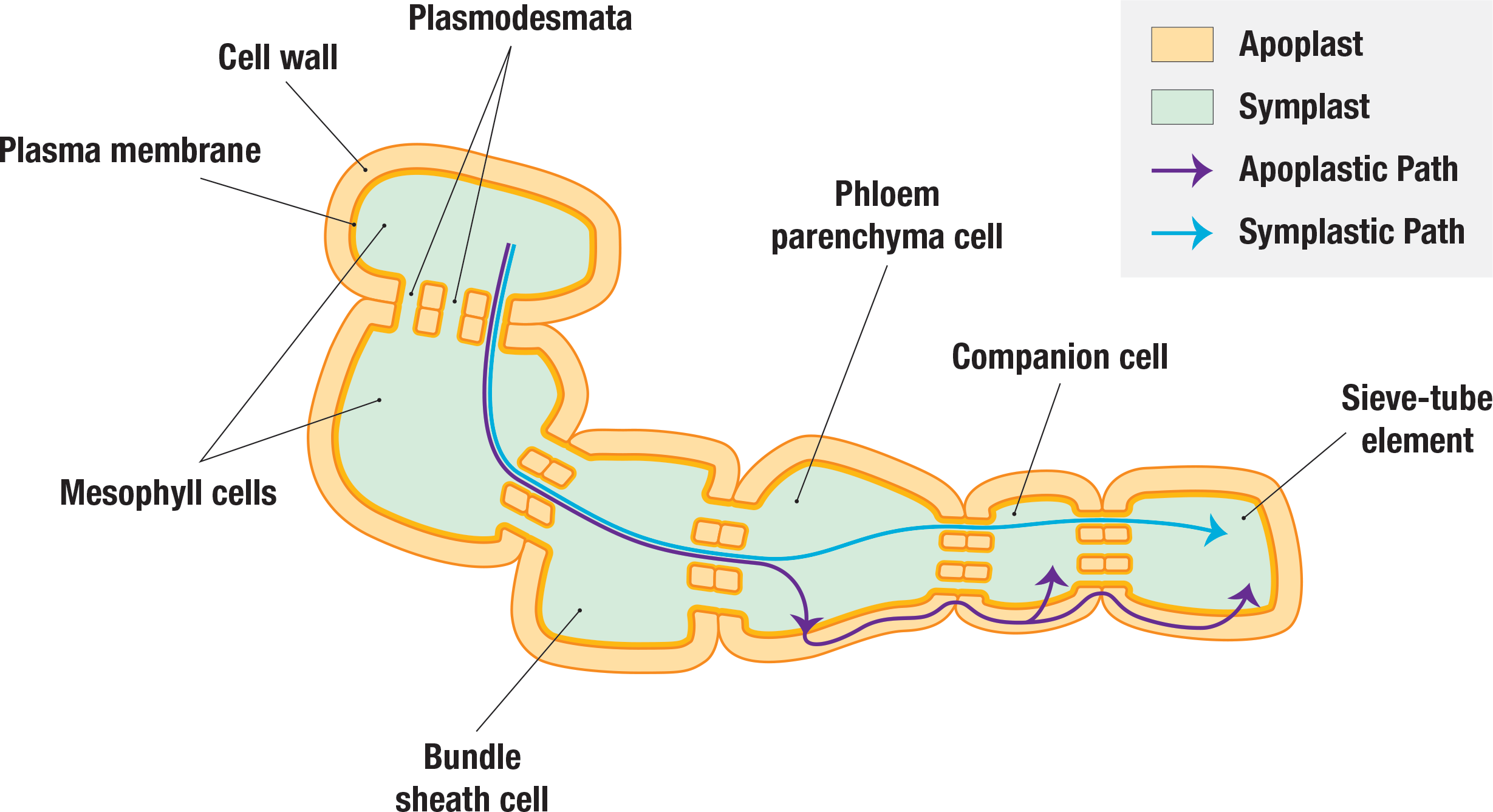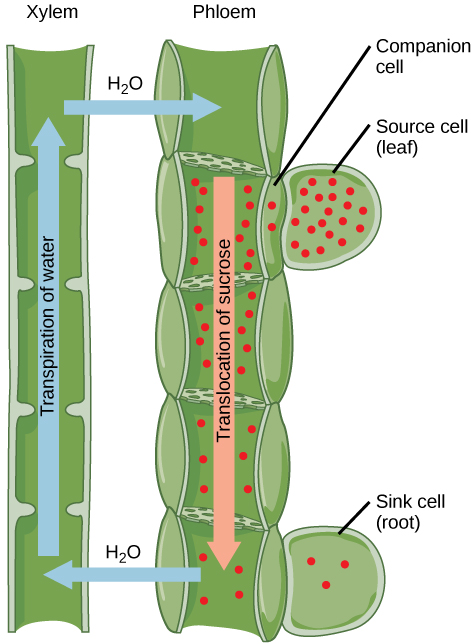4.5.2: Translocation (Assimilate Transport)
- Page ID
- 32039
Learning Objectives
- Distinguish between sources and sinks and provide examples of each.
- Explain the process of phloem loading, distinguishing between apoplastic and symplastic pathways.
- Explain how assimilate translocations through the phloem according to the pressure-flow hypothesis.
Plants need an energy source to grow. In seeds and bulbs, food is stored in polymers (such as starch) that are converted by metabolic processes into sucrose for newly developing plants. Once green shoots and leaves are growing, plants are able to produce their own food through photosynthesis. The products of photosynthesis (mainly the sugar sucrose) are a major component of the substance found in the phloem, called assimilate. Ions, amino acids, certain hormones, and other molecules are also found in assimilate. The movement of assimilate is called translocation, or assimilate transport.
Sources and Sinks
Structures that produce or release sugars for the growing plant are referred to as sources. Examples include mature leaves, which produce sugar through photosynthesis, and storage organs, such bulbs, tubers, or storage roots. Sources produce or store more sugars than they need themselves and can thus export sugars. The points of sugar delivery, such as most roots, young shoots, and developing fruits and seeds, are called sinks (Figure \(\PageIndex{1}\)). Because sinks do not produce enough sugars to meet their energy needs, they must import sugars from sources.

The pattern of assimilate flow changes as the plant grows and develops. Sugars are directed primarily to the roots early on, to shoots and leaves during vegetative growth, and to seeds and fruits during reproductive development. They are also directed to storage structures. Thus, the same organ may function as a source or a sink depending on the stage of development. For example, a young leaf may initially be a sink, but it will eventually grow and conduct enough photosynthesis to become a source. Similarly, a developing seed is a sink as the embryo develops. Once the seed germinates, however, starches stored in the seed break down, act as a source for the growing seedling structures.
The products from the source are usually translocated to the nearest sink through the phloem. For example, the highest leaves will send sugars upward to the growing shoot tip, whereas lower leaves will direct sugars downward to the roots. Intermediate leaves will send products in both directions, unlike the flow in the xylem, which is always unidirectional (soil to leaf to atmosphere).
Phloem Loading
Before discussing how sources transport sugars into the phloem (phloem loading), let's first review the conducting cells of the phloem. Stacks of these cylindrical cells called sieve-tube elements form column-like structures. Each cell is separated by a sieve plate (sieve-tube plate). The sieve plate has holes in it, like a slice of Swiss cheese, allowing for translocation. Lateral sieve areas on the side of the column allow different phloem tubes to interact. Sieve-tube elements have reduced cytoplasmic contents and rely on special parenchyma cells called companion cells, which assist with metabolic activities and provide energy (Figure \(\PageIndex{2}\)). In addition to sieve-tube elements and companion cells, the phloem contains other parenchyma cells and may contain sclerenchyma fibers. In leaves, the phloem is found in vascular bundles (leaf veins), which are surrounded by a bundle sheath. Sugars are produced through photosynthesis in the mesophyll cells that fill most of the leaf (see diagram in Transpiration section).

There are two pathways of phloem loading (Figure \(\PageIndex{3}\)). Both pathways begin the same way. The cytoplasms of most plant cells are interconnected via plasmodesmata.Augars through plasmodesmata from mesophyll cells to bundle sheath cells to the parenchyma cells of the phloem. From there, the pathways differ. The first pathway called apoplastic phloem loading, occurs when the regular parenchyma cells of phloem are not connected to the companion cells. In this case, sucrose must exist the regular parenchyma cells and enter the apoplast. It enters the companion cell cytoplasm as well as the inside of the sieve tube through secondary active transport. Protons are pumped into the apoplast (outside of the cells), when the protons re-enter the cells (move down their concentration gradient), they bring sucrose with them by flowing through carrier proteins called sucrose-proton symporters. In this way, sucrose is actively transported against its concentration gradient, and high sucrose concentrations accumulate in the assimilate of the phloem. The second pathway is symplastic phloem loading. When the regular parenchyma cells of the phloem are connected to companion cells via plamodesmata, sucrose can flow through the symplast all the way to the sieve-tube elements. There is no need for sucrose to leave the cytoplasm (enter the apoplast) and re-enter cells via sucrose-proton symport.

Pressure-Flow Hypothesis
What drives the movement of assimilate in the phloem? According to the pressure-flow hypothesis, assimilate moves due to osmosis of water to and from the xylem. While this is a passive process, it ultimately results from the active transport of sugars during phloem loading and unloading. In contrast with transpiration, an entirely passive process, translocation as a passive process that is indirectly driven by active processes.
Assimilate contains up to 30 percent sugar, and this high solute concentration decreases Ψs, which decreases the total water potential. The sugar concentration of the assimilate near sinks, where phloem loading occurs, is highest. This causes water to move by osmosis from the adjacent xylem into sieve tubes, thereby increasing pressure. The increase in pressure increases in total water potential causes the bulk flow of phloem from source to sink (Figure \(\PageIndex{4}\)). Sugar concentration in the sink cells is lower than in the sieve-tube elements because the sink sucrose has been metabolized for growth, or converted to starch for storage or other polymers, such as cellulose, for structural integrity. Unloading at the sink end of the phloem tube occurs by either diffusion or active transport of sucrose molecules from an area of high concentration to one of low concentration. Unloading reduces the sugar concentration of assimilate near sinks, increasing water potential. As a result, water moves from the phloem by osmosis and is then transpired or recycled via the xylem back into the phloem sap.

Attribution
Curated and authored by Melissa Ha using 30.5 Transport of Water and Solutes in Plants from Biology 2e by OpenStax (licensed CC-BY). Access for free at openstax.org.


